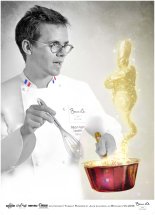CHROMA Whetstone
How to sharpen a kitchen knife?
(see photos below) or go to our video!
WHETSTONE
SHARPENING CNIVES WITH THE JAPANESE “V” EDGE
Our cnives are made from exceptional steel and the vast majority of them have the typical Japanese “V” edge. This edge makes our cnives sharper than many conventional kitchen cnives. But even the sharpest cnife at some point begins to lose its edge and needs resharpening. A regular whetstone could destroy an edge such as the more delicate “Single-bevel”.
Sharpen your high quality cnives by hand with a top of the line original CHROMA sharpening stone. For best sharpening results, we recommend using a rougher grain to pre-sharpen, a medium grain for regular care, and up to the finest grain for a polished finish. We also recommend the Sharpening Tutorial DVD for manual sharpening, available at CHROMA Cnife. Be sure to take note of our particular sharpening stone recommendations for each different cnife series. Better to buy one cnife less, and spend your money on a good sharpening stone instead!
Tip: Never allow your cnives to become entirely dull, always sharpen them before they reach that point!
Sharpening is so easy, even a child can do it. Check out our video at www.cnife.com
CHROMA HIGH GRADE WHETSTONES
200 – 240: Pregrinding of dull knives or smaller repair
800 - 2000: Standard – For regular sharpening / maintenance of edge.
3000 - 4000: For perfect sharpness - for use after the 1000's
6000 - 12000: Polishing – herewith the knife becomes ideal, for use after the 3000's
SHARPENING INSTRUCTIONS for all CHROMA Whetstones and Combination Whetstones (except ST-IS1, ST-IS2 and ST-IS3)
Initially soak the stone in water for 15 minutes. During sharpening, always keep the stone wet, you can sprinkle it with some water if you think it is drying out. The water works like a lubricant on the stone.
The knife should be held at a 10-20° angle to the whetstone. Then the knife is drawn off on the stone, in other words drawn back and forth with light pressure. During the grinding operation a sludge forms which assists the grinding of the edge. Knife blades with a single edge are sharpened on the right side to 80% and on left to 20%, whereas knives with edges on both sides are sharpened knives to 70% on the right and to 30% on the left. After sharpenimg the knife should be cleaned well with lukewarm water and SHARPENING & POLISHING INSTRUCTIONS for CHROMA READY-TO-USE-Whetstones ST-IS1, ST-IS2 UND ST-IS3
Pour a sufficient amount of water on the whetstone to moisten the surface. You can immediately begin with polishing. The right-hander starts polishing the right side of the knife – facing the point of the knife away from the body. Left-handers start with the left side of the blade.
Please hold the knife securely. Draw the blade back and forth in an angle as shown in the illustration. It is best to start polishing with the point of the knife continuing with the middle and the lower part of the blade. Once you detect an edge at the opposite side to the one you are polishing, proceed with the next part to be polished. Moisten the stone if necessary. The abrasive slurry which forms on the stone is very important to the polishing process and should be removed only after polishing. Repeat this process on the other side of the blade. This side requires less effort. Once the burr is removed the polishing is complete. The knife should be cleaned with lukewarm water and dried with a soft dishcloth. The whetstone should be rinsed with water and be dried afterwards.
TIPS FOR VALUE PRESERVATION OF YOUR JAPANESE COOKING KNIVES>/H4>
Never letthe knife get completely blunt. Sharpen it regularly with a high grade CHROMA whetstone. Like every good knife, a Japanese cooking knife never belongs in the dishwasher, because the aggressive salts attack the steel as surface rust. Also do not leave any knives in a wet sink.
After every use you should clean your knife with lukewarm water and dry it afterwards. Our knives are made of special steel and have the typical "V" JAPAN- GRINDING. This makes our knives sharper than all common kitchen knives. CHROMA knives remain sharp also longer than MANY others.
COMMON SHARPENING STEELS DESTROY YOUR KNIFE.
Sharpening steels are not sensibly usable with the hard Japanese blades on account of the blade geometry. A sharpening steel is not intended to acctually sharpen the knife, but to realign the edge to cut better. Product testers recommend whetstones for Japanese blades. Buy one knife less and invest in a good whetstone. Sharpen your knives regulary, before they become dulled (try the tomato test to find out the sharpness of your cooking knives). Always the same person should edge the knives. Everybody has an individual angle on which he grinds the knife. If now the angle is changed, the knife becomes duller than after the last sharpening. Beginners should use a sharpening guide rail, we recommend the inexpensive sharpening guide rail such as the CHROMA ST-G..
"Stiftung Warentest", a non-profit German consumer organisation conducting independant tests states (1/10) that sharpening steels are not suitable for Japanese knives. „Often they are harder than the sticks. They should not be sharpened with a stick, in order that the blades don't suffer damage.“
Watch the knife-sharpening-film on www.kochvideo.de – this should answer any questions you may have.
Whetstones are distributed worldwide by CHROMA France



